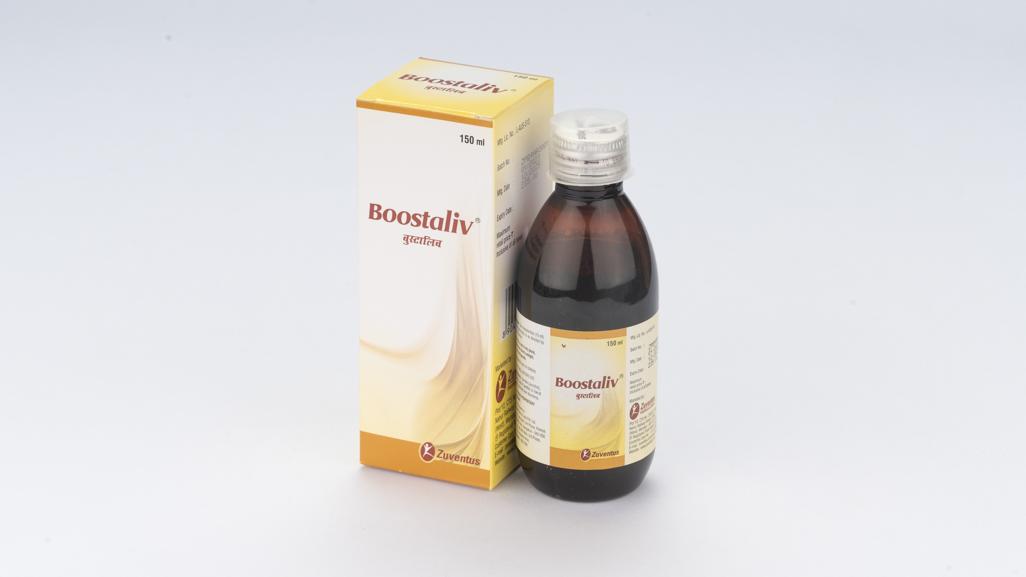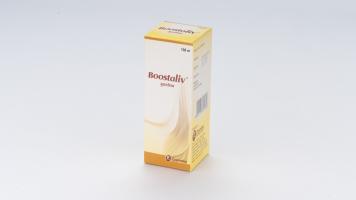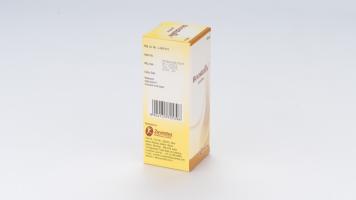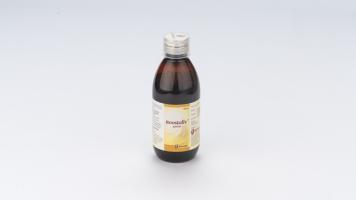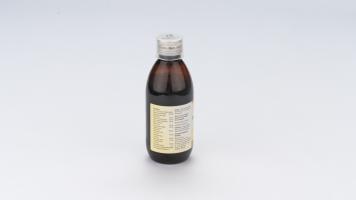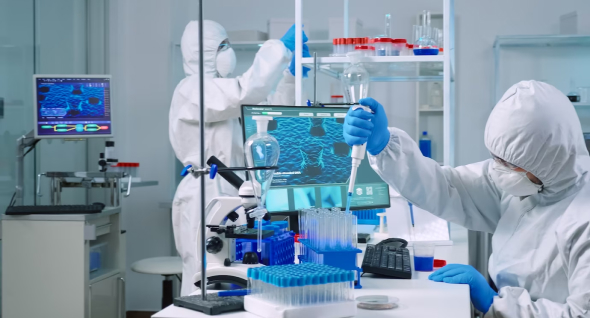Boostaliv Syrup
Therapy Area
Gastrointestinal
1.0 Generic name
Eclipta alba, Andrographis paniculata, Cyprus rotendus, Tinospora cardifolia, Silybum marianum, Terminalia arjuna, Phyllanthus niruri, Emblica officianalis, Terminalia chebula Piper longum and Terminalia bellirica syrup
2.0 Qualitative and quantitative composition
Each 10 ml of syrup contains extract:
Eclipta alba (Whole Plant) ……………………………. 125 mg
Andrographis paniculata (Whole Plant) …………………………………………………. 25 mg
Tinospora cardifolia (Stem)……………………………… 25 mg
Cyprus rotendus (Rhizome)………………………………. 50 mg
Silybum marianum (Whole Plant) ……………………. 35 mg
Terminalia arjuna (Bark)…………………………………… 50 mg
Phyllanthus niruri (Whole Plant) ………………………. 150 mg
Emblica officianalis (Fruit Pulp) …………………………. 50 mg
Terminalia chebula (Fruit Pulp) ………………………… 25 mg
Piper longum (Root)…………………………………………. 10 mg
Terminalia bellirica (Fruit Pulp) …………………………. 25 mg
Excipients & Flavours q.s.
Preservatives: Methylparaben Sodium & Propylparaben Sodium
3.0 Dosage form and strength
Syrup, 150 ml
4.0 Clinical particulars
4.1 Therapeutic indication
- Jaundice
- Anorexia / Loss of appetite
- Alcholic liver disease
4.2 Posology and method of administration
2 teaspoonfuls (10 ml) three times daily or as directed by the Physician.
4.3 Contraindications
Hypersensitivity to the active substance or to any of the excipients listed in the formulation.
4.4 Special warnings and precautions for use
No known warnings and precautions
4.5 Drugs interactions
No Clinically significant drug-drug interaction has been reported with Boostaliv syrup.
4.6 Use in special populations
Usage in pregnancy & lactation
Pregnant and lactating women should consult physician before starting treatment with Boostaliv syrup.
Usage in pediatrics
Physician supervision needed before starting treatment with Boostaliv syrup.
4.7 Effects on ability to drive and use machines
It is not known whether Boostaliv syrup alters the ability to drive. Do not drive if you experience any symptoms that affect your ability to concentrate and react.
4.8 Undesirable effects
There were no reported or observed significant adverse effects with Boostaliv syrup. However, mild side effects like nausea, gastritis, headache, bodyache, constipation, and insomnia have been reported.
Reporting of suspected adverse reactions
Reporting suspected adverse reactions after authorisation of the medicinal product is important. It allows continued monitoring of the benefit/risk balance of the medicinal product. Healthcare professionals are asked to report any suspected adverse reactions via email to: medico@zuventus.com
Website: https://www.zuventus.com/drug-safety-reporting
By reporting side effects, you can help provide more information on the safety of this medicine.
4.9 Overdose
No data on overdosage of this product. Available clinical studies demonstrate that Boostaliv syrup is safe and no significant adverse or toxic effects of Boostaliv syrup are observed in humans
5.0 Pharmacological properties
5.1 Pharmacodynamic properties
Eclipta Alba
Eclipta Alba is considered a powerful liver tonic. It elevates the activity of antioxidant enzymes SOD, CAT,GSH. Eclipta Alba has shown protective effect on experimental liver damage in rats and mice and also used for the treatment of liver cirrhosis and infective hepatitis by reducing centrilobular necrosis, hydropic degeneration and fatty change of the hepatic parenchymal cells. Eclipta Alba improves the both enzymatic and non-enzymatic antioxidant status.
Tinospora cordifolia
T. cordifolia played an important role in relieving the symptoms as well as normalization of altered liver function test when studied its effect against hepatotoxin CCl4. It is studied against the hepatic damage induced by a standard hepatotoxin – carbon tetra chloride (CCl4). T. cordifolia, it was proved to be effective in preventing fibrous changes and promoting regeneration by paranchymal tissue.
Andrographis paniculata
Andrographolide is extensively used as a stimulating agent for liver enzymes and hepatoprotective agent. Andrographolide increases the bile flow and bile salt production. Studies showed that Andrographolide is a potent hepatoprotective agent when compared with silymarin. Oral administration of the aqueous extract of plant in different doses caused a significant elevation of catalase, superoxide dismutase and glutathione-s-transferase (GSH) activities. It is a potent radical scavenging agent against various pathophysiological oxidants.
Cyprus rotendus
Rhizomes of C. rotundus (Cyperaceae) were evaluated for hepatoprotective activity in rats by inducing liver damage by carbon tetrachloride. It showed significant protective effect by lowering serum levels of liver enzymes like glutamic oxaloacetic transaminase, glutamic pyruvic transaminase, alkaline phosphatase and total bilirubin. It also showed positive changes on histopathology. Clinical studies have suggested that the gastroprotective action of C. rotundus is related to its inhibition of gastric motility and endogeneous prostaglandins.
Terminalia arjuna
T.arjuna demonstrated the hepatoprotective and antioxidant effect of Terminalia arjuna aqueous bark extract against Isoniazid induced hepatotoxicity. T.arjuna demonstrated the hepatoprotective and antioxidant effect of Terminalia arjuna aqueous bark extract against Isoniazid induced hepatotoxicity. Terminalia arjuna shows potential antioxidant and free radical scavenging activity due to presence of more amount of flavonoid and phenolic content. It significantly reduces the elevated levels of biochemical markers like SGPT, SGOT, ALP, ACP, Bilirubin. Plant extract treatment also increased the level of SOD and GSH.
T. bellirica
T. bellirica as a whole or its specific components possess ethnomedicinal attributes and are used in various herbal formulations. It is used as astringent, laxative, antipyretic, and anthelmintic agent. Fruits are useful in the treatment of asthma, bronchitis, hepatitis, diarrhea, piles, dyspepsia, eye diseases, hoarseness of voice, and scorpion-sting and also used as hair tonic. Fruit pulp is used in dysenteric-diarrhea, leprosy, piles, and dropsy.
Piper longum
Piperine is the major and active constituent of long pepper (Piper longum). Piperine as the world’s first bioavailability enhancer. Bioenhancers are such agents, which by themselves are not therapeutic entities but when combined with an active drug lead to the potentiation of the pharmacologic effect of the drug. Such formulations have been found to increase the bioavailability/bio efficacy of a number of drugs even when reduced doses of drugs are present in such formulations. Piperine increases the bioavailability, blood levels and efficacy of a number of drugs including ingredients of vasaka leaves, vasicine, sparteine, rifampicin, phenytoin, sulfadiazine and propranolol. It increases biavailability of silymarin. Thus dose required is lesser as compared to other silymarin preparations. It makes Boostaliv more potent at lower doses of silymarin.
Emblica officinalis
Hepatoprotective activity of emblica officinalis (EO) extracts was studied using carbon tetrachloride (CCI (4)) induced liver injury model in rats. It was found to inhibit the hepatotoxicity produced by acute and chronic CCI (4) administration as seen from the decreased levels of serum and liver lipid peroxides (LPO), glutamate-pyuvate transminase (GPT), and alkaline phosphatase (ALP). Chronic CCI (4) administration was also found to produce liver fibrosis as seen from the increased levels of collagen hydroxyproline and pathological analysis EO was found to reduce the elevated levels significantly, indicating that the extract could inhibit the induction of fibrosis in rats.
Phyllanthus niruri
The antioxidant hepatoprotective activity of P. niruri may be due to its rich content of flavonoids, tannins, lignans and terpenes, which possess antioxidative traits. It inhibits lipid peroxidation and prevent excessive superoxide synthesis. P. niruri may alleviate lipoprotein metabolism abnormalities, reduce cholesterol–phospholipid ratios, control biomembrane damage and decrease ROS-linked lipid peroxidation. It is also a potent NO-quenching agent.
This herb has been shown to significantly restore the reduced levels of GSH and various antioxidant enzymes and lower lipid peroxidation.
Studies focusing on the in-vivo hepatoprotective activity of P. niruri against paracetamolinduced hepatotoxicity observed the normalization of liver enzyme profiles. It also has hepatoprotective action against hepatotoxin like carbon tetrachloride.
Silybum marianum
Silymarin can inhibit the hepatic cytochrome P450 (CYP) detoxification system (phase I metabolism). This effect could explain some of the hepatoprotective properties of Silymarin, especially against the intoxication due to A. phalloides. The Amanita toxin becomes lethal for hepatocytes only after having been activated by the CYP system. Inhibition of toxin bioactivation may contribute to the limitation of its toxic effects. Additionally, silymarin, together with other antioxidant substances, could contribute towards protection against free radicals generated by enzymes of the CYP system.
Terminalia chebula
Terminalia chebula has been demonstrated to possess multiple pharmacological and medicinal activities, such as antioxidant, antimicrobial, antidiabetic, hepatoprotective, anti-inflammatory, antimutagenic, antiproliferative, radioprotective, cardioprotective, antiarthritic, anticaries, gastrointestinal motility and wound healing activity.
5.2 Pharmacokinetic properties
Andrographis paniculata
After giving ethanolic extract solid dispersion tablet (equivalent to 50 mg/Kg) to rats, the Cmax is 27.24±3.23 µg/mL with Tmax is of 1 hr. The Plasma half-life T1/2 11.74 ± 0.04 hr with AUC0- t and AUC0-α are 84.3±10.04 µg/mL, 420.0±32.2 µg.h/mL.
Silybum marianum
Silymarin is not soluble in water and is usually administrated in an encapsulated form. It is absorbed when given orally. Peak plasma concentration achieved in 6-8 hr. oral absorption of Silymarin is only about 23-47%, leading to low bioavailability of the compound. After oral administration the recovery of bile ranges from 2-3%. Silybin and the other components of Silymarin are rapidly conjugated with sulfate and glucoronic acid in liver and excreted through the bile.
Emblica officinalis
After giving 70 mg Emblica officinalis extract tablet to rabbits, the Cmax is 4.59±0.95µg/mL with Tmax is of 1.5±0.53 hr. The T1/2 is 6.0±0.33 hr, AUC0-24 and AUC0-∞ are 29.65±1.01 µg/mL, 32.60±1.02 µg.h/mL.
Eclipta alba
E. alba was found to be a strong inhibitor of CYP1A2 both in vitro and in vivo and may lead to serious herb-drug interaction if co-administered with other drugs that are metabolized by this enzyme.
Tinospora cordifolia
Tinospora cordifolia acts as immunomodulator by enhancing IgG antibodies, antifibrotic by hepatic regeneration, membrane stabilization, and Kupffer cell activation.
Terminalia arjuna
In vitro data indicated that the Terminalia arjuna extract contains constituents that can potentially inhibit the CYP3A and CYP2D isoenzymes which may in turn lead to pharmacokinetic drug–herb interaction.
Phyllanthus niruri
Phyllanthus amarus significantly inhibits the Metabolism of CYPA5 and CYPA7 enzymes which are essential enzymes responsible for phase 1 drug metabolism. Co-administration of Phyllanthus amarus with orthodox drugs that are completely metabolized by CYP3A Family can lead to therapeutic failure, drug interaction and adverse effect since it will interferes with it metabolism. Another study showed that CYP1A2, CYP2C9, CYP2D6 AND CYP3A4 enzymes were inhibited by aqueous extract of Phyllanthus amarus similarly human and rat glutathione S-transferases (GSTS) liver cytosolic enzyme was strongly inhibited by Phyllanthus amarus.
Terminalia bellirica (TB)
TB enhanced the differentiation of 3T3-L1 (mouse) cells to mature adipocytes and that one of the active main components was identified as gallic acid. Gallic acid (10–30 µM) enhanced the expression and secretion of adiponectin via adipocyte differentiation and also that of fatty acid binding protein-4, which is the target of peroxisome proliferator-activated receptor gamma (PPARγ), although it does not alter the expression of the upstream genes PPARγ and CCAAT enhancer binding protein alpha.
Piper longum
P. longum‘s anti-inflammatory quality may be linked to G-protein coupled signalling process (Module-4). This module contains genes like GRK2 and GRK6. Inflammatory mediators modulate GRKs signaling either by transcription regulation or its degradation. GRK2 act as mediator in the pathway that causes inflammatory pain. Thus, targeting GRKS by P. longum could be the reason of its anti-inflammatory properties.
Cyprus rotendus
Phenolic compounds from plant source have been found to be anti-inflammatory, which may be related to inhibition of COX activity and to anti-oxidant activity. They are also known to be toxic to bacterial cells and inhibit their growth at high concentrations.
T.chebula
T.chebula showed statistically significant reduction in the level of serum cholesterol, TG, TL, LDL and VLDL. There was a statistically significant increase in the level of HDL. Supplementation of T.chebula lowered the serum TL, TG, LDL-C and VLDL-C in heart patients.
6.0 Non clinical properties
6.1 Animal Toxicology or Pharmacology
No known animal toxicology data
7.0 Description
Boostaliv syrup is the combination of Eclipta alba (Whole Plant), Andrographis paniculata (Whole Plant), Tinospora cardifolia (Stem), Cyprus rotendus (Rhizome), Silybum marianum (Whole Plant), Terminalia arjuna (Bark), Phyllanthus niruri (Whole Plant), Emblica officianalis (Fruit Pulp), Terminalia chebula (Fruit Pulp), Piper longum (Root), and Terminalia bellirica (Fruit Pulp).
Boostaliv is a polyherbal formulation of solubilized Silymarin along with potent hepatoprotective herbs which synerzise the activity. The ingredients exhibit potent hepatoprotective properties in hepatotoxicity. They restore the functional efficiency of the liver by protecting the hepatic parenchyma and promoting hepatocellular regeneration. The antiperoxidative activity prevents the loss of functional integrity of the cell membrane, maintains cytochrome P-450 (a large and diverse group of enzymes, which catalyze the oxidation of organic substances), hastens the recovery period and ensures early restoration of hepatic functions in infective hepatitis. It facilitates the rapid elimination of acetaldehyde and ensures protection from alcohol-induced hepatic damage. The Formulation also diminishes the lipotropic effect in chronic alcoholic hepatitis and prevents fatty infiltration of the liver. In precirrhotic conditions, arrests the progress of cirrhosis and prevents further liver damage.
Hepatocyte regeneration
Boostaliv individual ingredient has shown protective effect on experimental liver damage in preclinical and clinical studies. They can also be used for the treatment of liver cirrhosis and infective hepatitis by reducing centrilobular necrosis, hydropic degeneration and fatty change of the hepatic parenchymal cells.
Improve Liver Functions
Silymarin and other herbs can normalize serum bilirubin, aspartate aminotransferase and alanin-aminotransferase values, while it can decrease gamma-glutamyl transferase activity and procollagen III peptide level in patients with chronic alcoholic liver disease
Anti-Inflammatory Effect
Silymarin inhibits lipid peroxidation which is a mechanism responsible for progression of liver damage, development of fibrosis and eventually cirrhosis. The common effects of silymarin on hepatocytes are anti-inflammatory and antifibrotic effects, antioxidant action and modulation of intrahepatic metabolic pathways.
Silymarin works as a hepatoprotective via: (1) preventing entry of various toxins, e.g., alcohol, carbon tetracholoride and heavy metals, into hepatocytes; (2) stimulating protein synthesis with hepatocyte regeneration; (3) acting as a free-radical scavenger and antioxidant; and (4) modulating the immune response (5) Inhibition of Kupffer cell functions and leukotriene formation.
Potent Anti-hepatotoxic Activities
Silymarin inhibits the hepatic cytochrome P450 detoxification system. This is especially responsible for its hepatoprotective efficacy against Amanita phalloides poisoning and free radicals generated by enzymes of CYP450 system.It is also considered a potent inhibitor of human intestinal β-glucuronidase, blocking the release and reabsorption of free xenobiotics and their metabolites from their glucuronide conjugate. Combination of silymarin with potent herbs make Boostaliv protective agent against hepatotoxic chemicals and drugs.This polyherbal combination also proves to be potential as prophylactic antioxidative agents. Herbs have supporting literature in the hepatoprotective and antioxidant effect against Isoniazid induced hepatotoxicity.
Antioxidant effect
Silymarin and constituents of Boostaliv exerts antioxidant action and prevents the depletion of glutathione in liver disorders. These herbs antagonize the depletion of the 2 main detoxifying mechanisms – (Glutathione) GSH and superoxide dismutase (SOD), by reducing the free radical load, increasing GSH levels and stimulating SOD activity. It also inhibits free radical induced lipid peroxidation.
Improves appetite
In anorexia and less than optimal growth and weight gain, As a daily health supplement, Boostaliv improves appetite, digestion and assimilation processes and promotes weight gain.
8.0 Pharmaceutical particulars
8.1 Incompatibilities
Not applicable
8.2 Shelf-life
Refer on pack
8.3 Packaging information
8.4 Storage and handing instructions
Store in a cool & dry place, away from direct sunlight. Do not refrigerate
9.0 Patient counselling information
- Follow your doctor's instructions on the dosage and duration of Boostaliv Syrup.
- Before using, read the directions on the label. Take it orally after measuring it.
- Before using, give it a good shake.
- Boostaliv Syrup can be taken with or without food, however It is best if you take it at the same time every day.
12. Date of revision of the text
15.07.2024
About Leaflet
Please read this leaflet carefully before you start using this medicine because it contains important information for you.
- Keep this leaflet. You may need to read it again.
- If you have any further questions, ask your doctor or pharmacist.
- This medicine has been prescribed for you. Do not pass it on to others. It may harm them, even if their signs of illness are the same as yours.
- If you get any side effects, talk to your doctor or pharmacist. This includes any possible side effects not listed in this leaflet.
What is in this leaflet
- What Boostaliv syrup is and what it is used for
- What you need to know before you use Boostaliv syrup
- How to use Boostaliv syrup
- Possible side effects
- How to store Boostaliv syrup
- Contents of the pack and other information
1. What Boostaliv syrup is and what it is used for
Boostaliv syrup contains a combination of herbal ingredients that work synergistically to protect and restore liver function. Here’s how some of the key ingredients work:
- Eclipta alba: Acts as a powerful liver tonic, enhancing antioxidant enzyme activities and protecting against liver damage.
- Tinospora cordifolia: Normalizes liver function tests and promotes liver regeneration by preventing fibrous changes.
- Andrographis paniculata: Stimulates liver enzymes, increases bile flow, and acts as a potent hepatoprotective agent.
- Cyprus rotendus: Protects the liver by lowering serum levels of liver enzymes and showing positive histopathological changes.
- Terminalia arjuna: Demonstrates hepatoprotective and antioxidant effects, reducing elevated biochemical markers and increasing antioxidant enzyme levels.
- Phyllanthus niruri: Possesses antioxidative properties, inhibits lipid peroxidation, and restores antioxidant enzyme levels.
- Silybum marianum (Silymarin): Inhibits hepatic cytochrome P450 detoxification system, acts as an antioxidant, and prevents toxin bioactivation.
- Terminalia chebula: Exhibits multiple pharmacological activities including hepatoprotective, antioxidant, and anti-inflammatory effects.
- Piper longum: Enhances the bioavailability of other ingredients, making Boostaliv syrup more potent at lower doses.
These ingredients collectively help in protecting the liver from toxins, promoting liver cell regeneration, and improving overall liver function. Boostaliv syrup is a herbal medicine used for:
- Jaundice
- Anorexia (loss of appetite)
- Alcoholic liver disease
2. What you need to know before you take Boostaliv syrup
Do not take Boostaliv syrup if:
- You are allergic to any of the ingredients.
Warnings and precautions:
- Consult your doctor if you are pregnant or breastfeeding.
- Consult your doctor before giving Boostaliv syrup to children.
Other medicines and Boostaliv syrup:
- No known significant drug interactions. However, always inform your doctor about any other medicines you are taking.
3. How to take Boostaliv syrup
Always take this medicine exactly as your doctor has told you. Check with your doctor or pharmacist if you are not sure.
Recommended dose:
Adults: 2 teaspoonfuls (10 ml) three times daily.
Follow your doctor’s instructions on the dosage and duration.
If you use more Boostaliv syrup than you should
Tell your doctor if you accidentally use more than you were told.
If you forget to use Boostaliv syrup
If you forget to take at the right time, use it as soon as you remember, then carry on as before. Do not take a double dose to make up for a forgotten dose.
If you stop using Boostaliv syrup
Do not stop your treatment even if you feel better unless told to do so by your doctor.
If you have any further questions on the use of this product, ask your doctor or pharmacist.
4. Possible side effects
Like all medicines, this medicine can cause side effects, although not everybody gets them.
Common side effects:
- Nausea
- Gastritis
- Headache
- Body ache
- Constipation
- Insomnia
Reporting of side effects
If you get any side effects, talk to your doctor, pharmacist or nurse. This includes any possible side effects not listed in this leaflet. You can also report side effects directly: Website: www.zuventus.com in and click the tab “Drug Safety Reporting” located on the top end of the home page. Website link: https://www.zuventus.com/drug-safety-reporting
By reporting side effects, you can help provide more information on the safety of this medicine. You can also report the side effect with the help of your treating physician.
5. How to store Boostaliv syrup
- Keep this medicine out of the sight and reach of children.
- Do not use this medicine after the expiry date which is stated on the label and carton after EXP.
- The expiry date refers to the last day of that month.
- Store in a cool and dry place, away from direct sunlight.
- Do not refrigerate.
Do not throw away any medicines via wastewater or household waste. Ask your pharmacist how to throw away medicines you no longer use. These measures will help protect the environment.
6. Contents of the pack and other information
What Boostaliv Syrup contains:
- Active ingredients: Eclipta alba, Andrographis paniculata, Tinospora cardifolia, Cyprus rotendus, Silybum marianum, Terminalia arjuna, Phyllanthus niruri, Emblica officianalis, Terminalia chebula, Piper longum, Terminalia bellirica.
- Preservatives: Methylparaben Sodium & Propylparaben Sodium.

